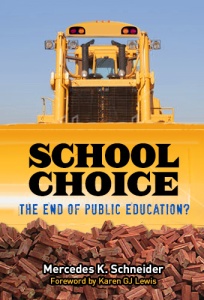Book Review: A Contest Without Winners: How Students Experience Competitive School Choice
Kate Phillippo, associate professor of cultural and educational policy studies at Loyola University Chicago’s School of Education, published a book in March 2019, entitled, A Contest Without Winners: How Students Experience Competitive School Choice.


Kate Phillippo
In her book, Phillippo offers details from the experiences of 36 Chicago Public Schools (CPS) eighth graders who attended one of two middle schools and who were vying for acceptance in a CPS high school of their choice.
Phillippo’s term, “competitive school choice,” is apt for two reasons: 1) the most prestigious and most preferred schools tended to be selective admissions (SA) schools, and 2) in general, CPS does not have enough places at schools that its eighth-grade students would actually choose to attend.
Let the games begin. (Indeed, one student likened CPS’ high school choice to “The Hunger Games.”)
In this “contest without winners,” students’ high school fates (and possibly, subsequent college and career fates) depend heavily upon their test scores and core subject grades from their seventh-grade year. If a student has an maturity/responsibility awakening in eighth grade, it is too late.
As it stands, Phillippo discovered (confirmed?) that with CPS’ high school choice demand, eighth graders were being asked to navigate a complex process of forms, meetings, and deadlines that was far above their developmental capabilities; students almost certainly needed some invested adult to effectively engage in CPS’ competitive high school choice process. However, that adult was unlikely to be a classroom teacher since teachers– to whom students often turned– felt the pressure to remain neutral in advising students regarding their choices due to the potential of being held liable if the student or parent were dissatisfied with the choice outcome.
Eighth graders who had an engaged adult available to help with the high school choice process definitely had an edge, as did students whose families had the means to devote resources (time, effort, money) to the process.
Too, Phillippo discovered that the competitive environment created a “me-first,” self-preservation attitude that negatively affected civic engagement among students. Though students might be learning lessons about civic responsibility in their classes, when it came to the pressured reality of securing that preferred CPS high school, application of civic responsibility was cast aside for the all-too-real lesson of “every eighth grader for him-/herself.”
Of course, all of this choice occurs in the context of massive school closures and charter school promotion not begun with but seriously exacerbated by former Chicago mayor, Rahm Emanuel, and crony, former CPS CEO and US secretary of education, Arne Duncan. The eighth graders in Phillippo’s study have grown up in an environment of mayoral control of schools and the ensuing chaos, which surely contributes to the pressurized atmosphere surrounding these eighth-graders’ competitive high school choice.
Phillippo time and again returns to the idea that the ideology of school choice is far from the stressful reality of CPS’ competitive school choice– and the ideologues appear to have no viable solution to the actual outcome of dissatisfaction permeating the process.
Even the students who were granted their preferred schools did not feel like winners.
And for the many who were not selected to attend their preferred schools (or any schools on their list, for that matter), they internalized the unhealthy (untrue) message that the System Knows Best and that their not being chosen meant that they must not be intelligent, capable (or of sufficient value). In short, students disappointed with the system-determined choice outcome often ended up believing that the disappointing outcome must mean that they, the students, were the disappointment.
And everyone knew to what schools everyone else was accepted. There was no way to keep this secret. Everyone knew when those notification letters had been mailed to students. The notification results were discussed openly in classrooms, with teachers initiating the discussion.
Phillippo also realized that perceptions of school quality are not independent of perceptions of the neighborhoods in which those schools are located, with students overwhelmingly preferring SA schools in predominately white sections of town to those located in predominately black and brown areas.
Despite efforts to achieve racial/ethnic balance in school admission, the most preferred schools continued to be located in white areas and continued to enroll disporportionately high numbers of white students.
As to “neighborhood schools”: These were mostly viewed as an undesirable last resort.
Though Phillippo’s study focused on Chicago, the experiences of the students in her work, coupled with her own discoveries about the competitive-school-choice “non-win” will no doubt resonate with students, parents, teachers, administrators, and others who find themselves confronting school choice in other locales.
A Contest Without Winners is organized as follows:
- Introduction: Competitive Choice Policy, the Students Who Enact It, and Its Social Backdrop
- Chapter 1: Unequal Opportunities, Unevenly Distributed: The Puzzle of Admissions Results
- Chapter 2: Education Policy Without Educators: How Competitive Choice Puts Responsibility for Quality Schooling on Students
- Chapter 3: The Sculptors and the Sculptures: How Neighborhoods Shape and Are Shaped by Competitive Choice Policy
- Chapter 4: Differentially Defended: Students’ Developmental Vulnerability to Competitive Choice, and Family Capital’s Buffering Role
- Chapter 5: Civic Education: How Competitive Choice Policy Encourages Civic Individualism
- Conclusion: Surprises, Lessons Learned, and a Few Paths Forward
Kate Phillippo’s, A Contest Without Winners: How Students Experience Competitive School Choice, offers fresh, engaging insight into the firsthand experiences of students navigating a school choice system indeed “without winners.”
I learned valuable information from every chapter and recommend the book without reservation.

__________________________________________________________________________________
Interested in scheduling Mercedes Schneider for a speaking engagement? Click here.
.


Mercedes. May we publish your review in Education Review?
Gene
Sure, Gene.
I suppose competitive college admissions is less onerous because the kids are older. What’s your view?
I agree; kids are developmentally up for the task, including able to initiate seeking help.